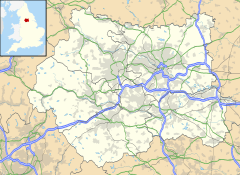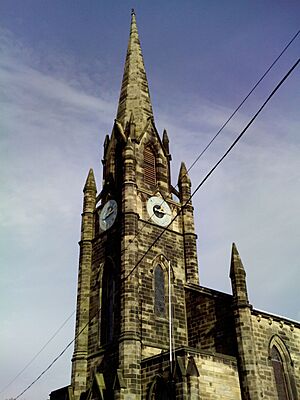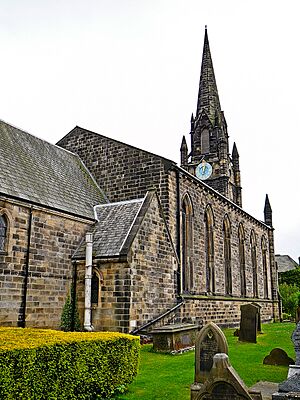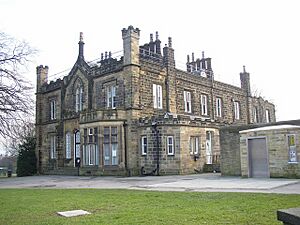Burley in Wharfedale facts for kids
Quick facts for kids Burley in Wharfedale |
|
|---|---|
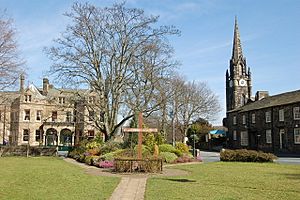 Village green |
|
| Population | 7,041 (2011 Census) |
| OS grid reference | SE165464 |
| • London | 175 mi (282 km) SSE |
| Civil parish |
|
| Metropolitan borough | |
| Metropolitan county | |
| Region | |
| Country | England |
| Sovereign state | United Kingdom |
| Post town | ILKLEY |
| Postcode district | LS29 |
| Dialling code | 01943 |
| Police | West Yorkshire |
| Fire | West Yorkshire |
| Ambulance | Yorkshire |
| EU Parliament | Yorkshire and the Humber |
| UK Parliament |
|
Burley in Wharfedale is a lovely village in West Yorkshire, England. It is located in the beautiful Wharfedale valley. In 2011, about 7,041 people lived there.
The village is easy to reach, sitting right on the A65 road. It is about 11 miles (18 km) north-west of Leeds and 8 miles (13 km) north of Bradford. Nearby towns include Ilkley, which is 3 miles (5 km) away, and Otley, just 2 miles (3 km) away. A smaller area called Burley Woodhead is about 1 mile (1.6 km) to the south-west, at the bottom of Burley Moor.
Contents
What's in a Name? The Meaning of Burley in Wharfedale
The name Burley in Wharfedale has a long history! It first appeared around the year 972. Back then, it was called Burhleg. Later, in the Domesday Book of 1086, it was written in different ways like Burgelei or Burghelay.
The name comes from two old English words. Burg means 'fortification' or 'stronghold'. Lēah means 'open land in a wood'. So, Burley likely meant 'open land in a wood with a fortification'. The extra part, 'in Wharfedale', was added later. This helped people know it was different from other places named Burley. It first appeared in the 1200s as Burghlay in Querfildale.
A Look Back: The History of Burley in Wharfedale
Burley in Wharfedale started as a small farming community. It probably has roots going back to Roman and Anglo-Saxon times. In the late 1700s and 1800s, Burley grew into an industrial village. Many people worked at Greenholme Mills, which were cotton factories. These mills used water power from the River Wharfe.
The cotton mill is no longer working today. It has been turned into apartments. However, the water channel, called a goit, is still used. It now helps create hydroelectric power. There is also a weir, which is a small dam, that remains.
In the early 1900s, big changes came to the village. Cities like Leeds and Bradford grew, offering many jobs. New train and bus links made it easy to travel. This made Burley a "dormitory settlement." This means people lived in Burley but traveled to work in the nearby cities.
In the 1920s and 1950s, council housing was built. By the late 1900s, Burley became a successful village with many different kinds of people. It has many older, retired people, as well as young families. These families are often drawn by job chances, good local schools, and new homes.
Burley used to be a small area called a township. It was part of the Otley parish. In 1866, it became its own civil parish. But on April 1, 1937, it joined with Ilkley. In 1931, about 3,961 people lived in the parish.
Then, on April 1, 2006, something special happened. After people asked the local authority and got permission from the Parliament, Burley became a separate parish again. It is now simply called "Burley."
Life in Burley: Community and Schools
Burley in Wharfedale has a population of 7,041 people. Along with Menston, Burley is part of the Wharfedale ward. This ward is in the metropolitan borough of the City of Bradford.
The village has many local businesses. Public buildings in Burley include the Queens' Hall. This hall was first built as a place for mill workers to learn and attend lectures. Community groups have worked hard to improve the village. They have created a new nature reserve and improved the village green, which has a nice water feature.
Burley has two public primary schools: Burley and Woodhead Primary School, and Burley Oaks Primary School. There is also Ghyll Royd School & Pre-School. This is a private primary and nursery school for children aged 2 to 11. The school started in 1889. It used to be only for boys but became co-educational in 1999 when it moved to Greystone Manor.
You can find several churches in Burley. These include churches for Anglicans, Calvinists, and Methodists. The Roman Catholic church, dedicated to Saints John Fisher and Thomas More, is located between Burley in Wharfedale and Menston. The main Anglican church is called St Mary's.
Burley offers many types of homes. You can find older terrace houses and cottages in the village center. A former hospital, Scalebor Park Hospital, has been turned into private townhouses and flats.
The village has its own railway station. It is on the Wharfedale Line. This means you can take direct trains to Leeds, Bradford, and Ilkley. You can also easily connect to other nearby towns and cities.
Famous Faces: Notable People from Burley
Burley has been home to some interesting people!
- The television presenter Richard Whiteley lived in Burley Woodhead until he passed away in 2005.
- Walter of Burley (1274–1344), a famous medieval thinker and theologian, might have been born here.
- William Forster, an important politician in the 1800s, partly owned a mill in the village and is buried there.
- Mark James, who was the captain of the Ryder Cup golf team in 1999, lives in the village.
- British cyclist Scott Thwaites is from Burley. In 2012, he won the Men's Elite Road Race Championship.
- John Peele Clapham, a magistrate and treasurer, had Burley Grange and the Salem Church built on Main Street.
- Tom Sumner received an MBE award in 2000. This was for his great service to the community in Burley-in-Wharfedale.
Location Grid
 |
Askwith |  |
||
| Ben Rhydding | Menston | |||
| Burley Woodhead |
See also
 In Spanish: Burley in Wharfedale para niños
In Spanish: Burley in Wharfedale para niños


